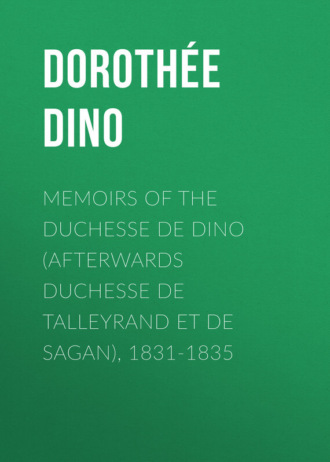 полная версия
полная версияMemoirs of the Duchesse de Dino (Afterwards Duchesse de Talleyrand et de Sagan), 1831-1835
25
The new Cabinet was constituted as follows: First Lord of the Treasury, Lord Melbourne; Chancellor, Lord Brougham; Lord President of the Council, the Marquess of Lansdowne; Secretary of State for Foreign Affairs, Viscount Palmerston; Secretary of State for the Colonies, Mr. Spring Rice; Chancellor of the Exchequer, Lord Althorp; First Lord of the Admiralty, Lord Auckland; Postmaster-General, Marquess of Conyngham; Paymaster-General of the Forces, Lord John Russell; Chief Secretary to the Lord Lieutenant of Ireland, Mr. Littelton. Chancellor of the Duchy of Lancaster, Lord Holland; Home Secretary, Viscount Duncannon; President of the Board of Control, Mr. Charles Grant; President of the Board of Trade, Mr. Poulett Thomson; Secretary of State for War, Mr. Ellice; Lord Privy Seal, Lord Mulgrave. Most of these Ministers had been members of the previous Cabinet.
26
Marshal Soult had been President of the Council since 1832. He resigned that office in July 1834.
27
Kew is situated on the right bank of the Thames. The palace was for some time the residence of the Duke and Duchess of Cumberland before their accession to the Throne of Hanover. There are an Observatory and a Botanical Garden at Kew, which were founded by George III.
28
Myrza-Rhyza-Kan, Envoy Extraordinary of Seth-Ali, Shah of Persia, to Napoleon I, at Warsaw, in March 1807.
29
Eminin-Effendi, accredited by the Sultan Mustapha IV. to the Emperor Napoleon at Warsaw in March 1807.
30
Lagrange-Chancel was concerned in the conspiracy of Cellamare, and launched against Philippe d'Orléans three virulent pamphlets in verse, which were soon followed by two others. (Philippiques, 1720.)
31
Rochecotte is a château built at the end of the eighteenth century which the Duchesse de Dino bought in 1825, and afterwards improved and greatly extended. In 1847 she presented it to her daughter the Marquise de Castellane. Rochecotte is charmingly situated on the slope of the Loire Valley, commanding the village of Saint Patrice, in the Department of Indre et Loire.
32
Langeais is a large town rather more than two leagues from Rochecotte. It is situate on the right bank of the Loire, and is dominated by a castle built in 992, and reconstructed in the thirteenth century by Pierre de la Brosse. In 1491 the marriage of King Charles VIII. and Anne de Bretagne was solemnised there.
33
Mlle. Henriette Larcher, governess to Mlle. Pauline de Périgord.
34
This letter has already been published in the little book by the Countess de Mirabeau entitled, Le Prince de Talleyrand et la Maison d'Orléans, which appeared in 1890.
35
See the London Chronicle for August 6, 1834.
36
The Porter at Valençay.
37
In 1793 Montrond had fled to England, and there had placed himself under M. de Talleyrand's protection. This was the beginning of their long friendship.
38
Madame Adélaïde had caused her hand to be offered to the Baron de Montmorency, but on condition that she should not be required to change her name – a condition which the Baron declined to accept.
39
Veuil commands the valley of Nahon, and was joined to the Seigneurie of Valençay in 1787 by M. de Luçay, who was then the owner. The castle, which must have been very fine, is now a ruin, of which only a fragment is inhabited by a farmer.
40
The Duchesse de Dino never revisited England in spite of her happy memories of that country.
41
When you entered this shop, then very celebrated in France, you used to see models of the legs of all M. de Talleyrand's lady friends, duly labelled, which had been made for the guidance of the Valençay tradesman.
42
Souvent femme varie
Bien fol est qui s'y fie
43
It ended in a criminal trial, which attracted much attention. Emile de la Roncière was tried by Jury at Angers in 1835, and, in spite of the ability of his counsel, Maître Chaix-d'Est-Ange, he was condemned to ten years' penal servitude. In 1843 King Louis-Philippe remitted the two years he had still to serve.
44
This letter, of which only a part is quoted here, was given entire by the Comtesse de Mirabeau in her book Le Prince de Talleyrand et la Maison d'Orléans, and may also be found in Volume V. of the Mémoires du Prince de Talleyrand, which were published in 1892.
45
Here is the full text of M. de Talleyrand's letter of resignation, which I give though it has already appeared in the Mémoires:
"To the Minister of Foreign Affairs.
"Monsieur le Ministre,
"When the King's confidence called me, four years ago, to the Embassy at London the very difficulty of the task made it a duty to obey, and I believe I have secured in a manner useful to France and to his Majesty two interests which I have always in mind. The peace of Europe has been preserved throughout those years, and this has simplified all our relations with foreign Powers. Our policy, formerly isolated, is now linked with that of other nations; it has been accepted, appreciated, and respected by honest men of every country. The co-operation of England, which we have obtained, has cost us nothing in independence, and has never offended our national susceptibilities. Such has been our respect for the rights of every one, such has been the frankness of our methods that, far from inspiring distrust, it is our guarantee which is now being sought against the propagandist spirit which is perturbing the older Europe. It is undoubtedly to the merits and abilities of the King that we must attribute results so satisfactory. For myself, I make no other claim than to have been the first to divine the profound idea underlying his Majesty's policy, and to have announced it to others whom subsequent events have persuaded of the truth of my words. But now that Europe knows and admires the King, and that, for this very reason, the principal difficulties are surmounted; now that England has perhaps as great need as we of our mutual alliance, and the line she seems disposed to take requires a mind whose traditions are less old-fashioned than mine; now I think that, without any want of devotion to the King and to my country, I may respectfully beg his Majesty to accept my resignation; and I beg you, M. le Ministre, to be so good as to present it to him. My great age and the infirmities which are its natural consequence, the repose which it demands and the thoughts which it suggests, make this step a very natural one and justify it only too well, making it, indeed, no less than my duty. I trust to the justice and kindness of the King to judge.
"I avail, &c., "Le Prince de Talleyrand.
"Valençay, November 13, 1834."
This letter was published in the Moniteur Universel of January 7, 1835.
46
The Whig Cabinet of Lord Melbourne fell on November 15, and was replaced by a Tory Ministry which was not destined to last more than three months. The Premier was Sir Robert Peel, and the Duke of Wellington replaced Lord Palmerston at the Foreign Office.
47
Of Armand Carrel, of the National.
48
This letter, of which only the beginning is given here, is dated November 25, and is quoted in full in Le Prince de Talleyrand et la Maison d'Orléans, and also in Volume V. of the Prince's Mémoires.
49
A Royal decree had charged the Court of Peers with the duty of trying the authors of the Republican insurrection which occurred from April 7 to April 13, 1834, in several provincial towns and in Paris. The sentences were not passed till December 1835 and January 1836.
50
The crime of Fieschi who tried to assassinate King Louis-Philippe.
51
The Abbaye-aux-Bois was a religious community of women; it was situated in Paris at the corner of the Rue de Sèvres and the Rue de la Chaise. During the Revolution it was used as a place of detention. Later it reverted to its former character, and, besides the convent occupied solely by the nuns, it afforded a peaceable refuge to ladies of great fashion. Madame Récamier settled there.
52
Fieschi's attempt on the King's life.
53
The burial of General Lamarque, who died of cholera on June 2, 1832, took place on June 5, and was the occasion of a revolt which continued all day on the 6th.
54
A castle belonging to the Duc de Montmorency.
55
An allusion to the request made to the King by M. de Talleyrand that M. de Bacourt should be appointed to Carlsruhe.
56
In 1789 the Cours Prévôtales were tribunals empowered to punish summarily and without appeal certain crimes and offences defined by an Ordinance of 1731. Under the Consulate and the Empire exceptional jurisdictions were established under the same name to deal with desertions, mutiny, political offences and smuggling. The Cours Prévôtales of the Restoration were composed of Judges of Courts of first instance, and were directed by a Prévôt, a superior officer of the army. These Courts from 1815 to 1817 took cognisance of offences against the public safety and acted retrospectively; they were an instrument of Reaction and Political vengeance.
57
September 22 is the day of Saint Maurice, the patron Saint of M. de Talleyrand.
58
This speech is given at the end of this volume. I shall quote only the phrase here referred to. "England, like France, repudiates in her foreign relations the principle of interfering in the affairs of her neighbours, and the ambassador of a monarchy established by the unanimous votes of a great people feels himself at ease in a land of liberty, in the presence of a scion of the illustrious House of Brunswick."
59
In 1830 the signatories of the celebrated decrees which led to the fall of Charles X., MM. de Polignac, de Peyronnet, Guernon de Ranville, and Chantelauze, were prosecuted before the House of Peers, deprived of their titles, and condemned to perpetual imprisonment. They were then confined at Ham.
60
The speech here mentioned was made on October 10, 1835, at Warsaw by the Emperor Nicolas, in the presence of the Corporation of that City, whom he was addressing. The Imperial words were filled with threats and reproaches to the Poles, formulated in terms so violent that they astonished Europe, where their authenticity was largely doubted. The allusions to clandestine relations maintained by the Polish rebels with foreign Powers, embarrassed more than one diplomatist, and more than one Government. This speech was published by the Journal des Débats of November 11, 1835, and will be found in the Appendix to this volume.
61
This speech first appeared in the National. The Moniteur reproduced it some days later.





